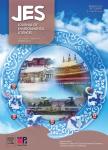Insight into removal of dissolved organic matter in post pharmaceutical wastewater by coagulation-UV/H_2O_2
Insight into removal of dissolved organic matter in post pharmaceutical wastewater by coagulation-UV/H_2O_2作者机构:State Key Laboratory of Water Environment SimulationSchool of EnvironmentBeijing Normal University State Key Laboratory of Environmental Criteria and Risk AssessmentChinese Research Academy of Environmental Sciences
出 版 物:《Journal of Environmental Sciences》 (环境科学学报(英文版))
年 卷 期:2019年第31卷第2期
页 面:329-338页
核心收录:
学科分类:0830[工学-环境科学与工程(可授工学、理学、农学学位)] 08[工学]
基 金:supported by the National Key Scientific and Technological Project for Water Pollution Control and Management (Nos.2012ZX07202-005 2012ZX07202-002 2014 ZX07216001-2)
主 题:Post PhWW Coagulation UV/H2O2 PARAFAC DOM fractionation Toxicity
摘 要:The removal of four dissolved organic matter(DOM) fractions, non-acid hydrophobics,hydrophobic acids, hydrophilics and transphilics, was achieved by coagulation-UV/H_2O_2 oxidation in post-pharmaceutical wastewater(PhW W). Coagulation with Polyferric chloride(PFC), Polymeric ferric sulfate(PFS) and Polymeric aluminum ferric chloride(PAFC) was studied separately to evaluate the effects of the initial pH and coagulant dosage. The coagulation-UV/H_2O_2 oxidation method resulted in much higher reduction rates for dissolved organic carbon(DOC)(by 75%) and UV_(254)(by 92%) than coagulation or UV/H_2O_2 oxidation alone. The proportion of non-acid hydrophobics, hydrophobic acids, transphilics and hydrophilics removed by coagulation was 54%, 49%, 27% and 12 %, while the combined treatment removed 92%, 87%,70% and 39%, respectively. Parallel factor analysis(PARAFAC) of fluorescence measurements revealed that the humic-like fluorescent component C4 showed the highest removal(by 44%)during the coagulation stage. After coagulation-UV/H_2O_2 treatment, the humic-like fluorescent component C3 had the highest removal(by 72%), whereas xenobiotic organic fluorescent components C1 and C4 remained recalcitrant to decomposition. Significant correlations(R2 0.8)between C1 and the hydrophobic acids and non-acid hydrophobics suggested the possibility of using fluorescence spectroscopy as an effective tool to assess variations in DOM fraction treatment efficacy in coagulation-UV/H_2O_2 systems. After the combined treatment, toxic inhibition of cellular activity by post PhW W decreased from 88% to 47% and biodegradability increased from 0.1 to 0.52.



